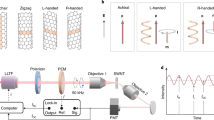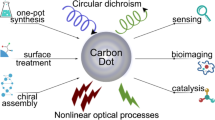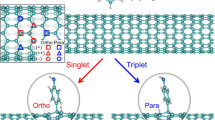Abstract
Chiral selective reactivity and redox chemistry of carbon nanotubes are two emerging fields of nanoscience. These areas hold strong promise for producing methods for isolating nanotubes into pure samples of a single electronic type, and for reversible doping of nanotubes for electronics applications. Here, we study the selective reactivity of single-walled carbon nanotubes with organic acceptor molecules. We observe spectral bleaching of the nanotube electronic transitions consistent with an electron-transfer reaction occurring from the nanotubes to the organic acceptors. The reaction kinetics are found to have a strong chiral dependence, with rates being slowest for large-bandgap species and increasing for smaller-bandgap nanotubes. The chiral-dependent kinetics can be tuned to effectively freeze the reacted spectra at a fixed chiral distribution. Such tunable redox chemistry may be important for future applications in reversible non-covalent modification of nanotube electronic properties and in chiral selective separations.
This is a preview of subscription content, access via your institution
Access options
Subscribe to this journal
Receive 12 print issues and online access
$259.00 per year
only $21.58 per issue
Buy this article
- Purchase on Springer Link
- Instant access to full article PDF
Prices may be subject to local taxes which are calculated during checkout








Similar content being viewed by others
References
Saito, R., Dresselhaus, G. & Dresselhaus, M. S. Physical Properties of Carbon Nanotubes (Imperial College Press, London, 1998).
Bachilo, S. M. et al. Narrow (n,m)-distribution of single-walled carbon nanotubes grown using a solid supported catalyst. J. Am. Chem. Soc. 125, 11186–11187 (2003).
Maruyama, S., Miyauchi, Y., Murakami, Y. & Chiashi, S. Synthesis of single-walled carbon nanotubes with narrow diameter-distribution from fullerene. Chem. Phys. Lett. 375, 553–559 (2003).
Miyauchi, Y., Chiashi, S., Murakami, Y., Hayashida, Y. & Maruyama, S. Fluorescence spectroscopy of single-walled carbon nanotubes synthesized from alcohol. Chem. Phys. Lett. 387, 198–203 (2004).
Banerjee, S. & Wong, S. S. Selective metallic tube reactivity in the solution-phase osmylation of single-walled carbon nanotubes. J. Am. Chem. Soc. 126, 2073–2081 (2004).
Banerjee, S. & Wong, S. S. Demonstration of diameter-selective reactivity in the sidewall ozonation of SWNTs by resonance Raman spectroscopy. Nano Lett. 4, 1445–1450 (2004).
Strano, M. S. et al. Electronic structure control of single-walled carbon nanotube functionalization. Science 301, 1519–1522 (2003).
Kavan, L., Rapta, P. & Dunsch, L. In situ Raman and Vis-NIR spectroelectrochemistry at single-walled carbon nanotubes. Chem. Phys. Lett. 328, 363–368 (2000).
Kavan, L. et al. Electrochemical tuning of electronic structure of single-walled carbon nanotubes: in-situ Raman and vis-NIR study. J. Phys. Chem. B 105, 10764–10771 (2001).
Stoll, M., Rafailov, P. M., Frenzel, W. & Thomsen, C. Electrochemical and Raman measurements on single-walled carbon nanotubes. Chem. Phys. Lett. 375, 625–631 (2003).
Okazaki, K., Nakato, Y. & Murakoshi, K. Absolute potential of the Fermi level of isolated single-walled carbon nanotubes. Phys. Rev. B 68, 035434 (2003).
Corio, P., Jorio, A., Demir, N. & Dresselhaus, M. S. Spectro-electrochemical studies of single wall carbon nanotube films. Chem. Phys. Lett. 392, 396–402 (2004).
Strano, M. S. et al. Reversible, band-gap-selective protonation of single-walled carbon nanotubes in solution. J. Phys. Chem. B 107, 6979–6985 (2003).
Weisman, R. B., Bachilo, S. M. & Tsyboulski, D. Fluorescence spectroscopy of single-walled carbon nanotubes in aqueous suspension. Appl. Phys. A 78, 1111–1116 (2004).
Zheng, M. & Diner, B. A. Solution redox chemistry of carbon nanotubes. J. Am. Chem. Soc. 126, 15490–15494 (2004).
Chattopadhyay, D., Galeska, I. & Papadimitrakopoulos, F. A route for bulk separation of semiconducting from metallic single-wall carbon nanotubes. J. Am. Chem. Soc. 125, 3370–3375 (2003).
Zheng, M. et al. Structure-based carbon nanotube sorting by sequence-dependent DNA assembly. Science 302, 1545–1548 (2003).
Huang, S. M., Maynor, B, Cai, X. Y. & Liu, J. Ultralong, well-aligned single-walled carbon nanotube architectures on surfaces. Adv. Mater. 15, 1651–1655 (2003).
Zheng, L. et al. Ultralong single-wall carbon nanotubes. Nature Mater. 3, 673–676 (2004).
Collins, P. G., Arnold, M. S. & Avouris, P. Engineering carbon nanotubes and nanotube circuits using electrical breakdown. Science 292, 706–713 (2001).
An, L., Lu, C. & Liu, J. A simple chemical route to selectively eliminate metallic carbon nanotubes in nanotube network devices. J. Am. Chem. Soc. 126, 10520–10521 (2004).
O'Connell, M. J. et al. Band gap fluorescence from individual single-walled carbon nanotubes. Science 297, 593–596 (2002).
Jana, A. K., Mukhopadhyay, S. K. & Bhowmik, B. B. Absorption spectra of 7, 7, 8, 8-tetracyanoquinodimethane in micellar solutions. Spectrochim. Acta A 57, 2687–2893 (2001).
Moore, V. C., Strano, M. S., Haroz, E. H., Hauge, R. H. & Smalley, R. E. Individually suspended single-walled carbon nanotubes in various surfactants. Nano Lett. 3, 1379–1382 (2003).
Doorn, S. K., Heller, D. A., Barone, P. W., Usrey, M. L. & Strano, M. S. Resonant Raman excitation profiles of individually dispersed single walled carbon nanotubes in solution. Appl. Phys. A 78, 1147–1155 (2004).
O'Connell, M. J., Sivaram, S. & Doorn, S. K. Near-infrared resonance Raman excitation profile studies of single-walled carbon nanotube intertube interactions: a direct comparison of bundled and individually dispersed HiPco nanotubes. Phys. Rev. B 69, 235415 (2004).
Zhao, J., Han, J. & Lu, J. P. Work functions of pristine and alkali-metal intercalated carbon nanotubes and bundles. Phys. Rev. B 65, 193401 (2002).
Lai, R. Y. & Bard, A. J. Electrogenerated chemiluminescence 71. Photophysical, electrochemical, and electrogenerated chemiluminescent properties of selected dipyrromethene-BF2 dyes. J. Phys. Chem. B 107, 5036 (2003).
Acknowledgements
We thank Ming Zheng for sharing his results on K2IrCl6 oxidation of nanotubes before publication. M.O'C. acknowledges the support of the DCI postdoctoral fellowship program. This work was supported in part by the LANL LDRD program.
Author information
Authors and Affiliations
Corresponding author
Ethics declarations
Competing interests
The authors declare no competing financial interests.
Supplementary information
Supplementary Information
Supplementary figures S1, S2 and S3 (PDF 213 kb)
Rights and permissions
About this article
Cite this article
O'Connell, M., Eibergen, E. & Doorn, S. Chiral selectivity in the charge-transfer bleaching of single-walled carbon-nanotube spectra. Nature Mater 4, 412–418 (2005). https://doi.org/10.1038/nmat1367
Received:
Accepted:
Published:
Issue Date:
DOI: https://doi.org/10.1038/nmat1367
This article is cited by
-
High-throughput optical imaging and spectroscopy of individual carbon nanotubes in devices
Nature Nanotechnology (2013)
-
Empirical Prediction of Electronic Potentials of Single-Walled Carbon Nanotubes With a Specific Chirality (n,m)
Scientific Reports (2013)
-
Photoluminescence imaging of electronic-impurity-induced exciton quenching in single-walled carbon nanotubes
Nature Nanotechnology (2012)



